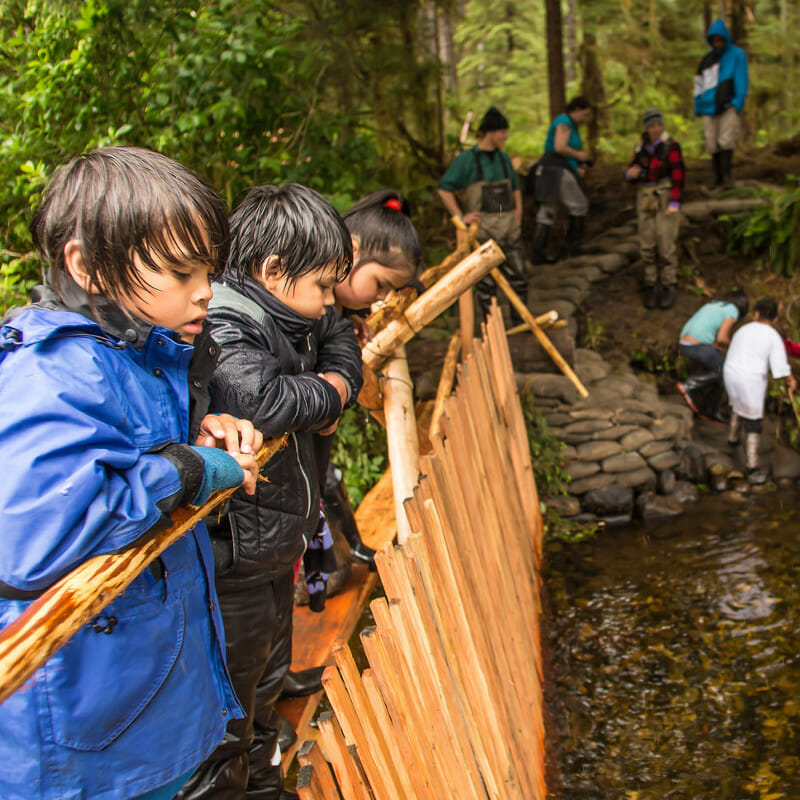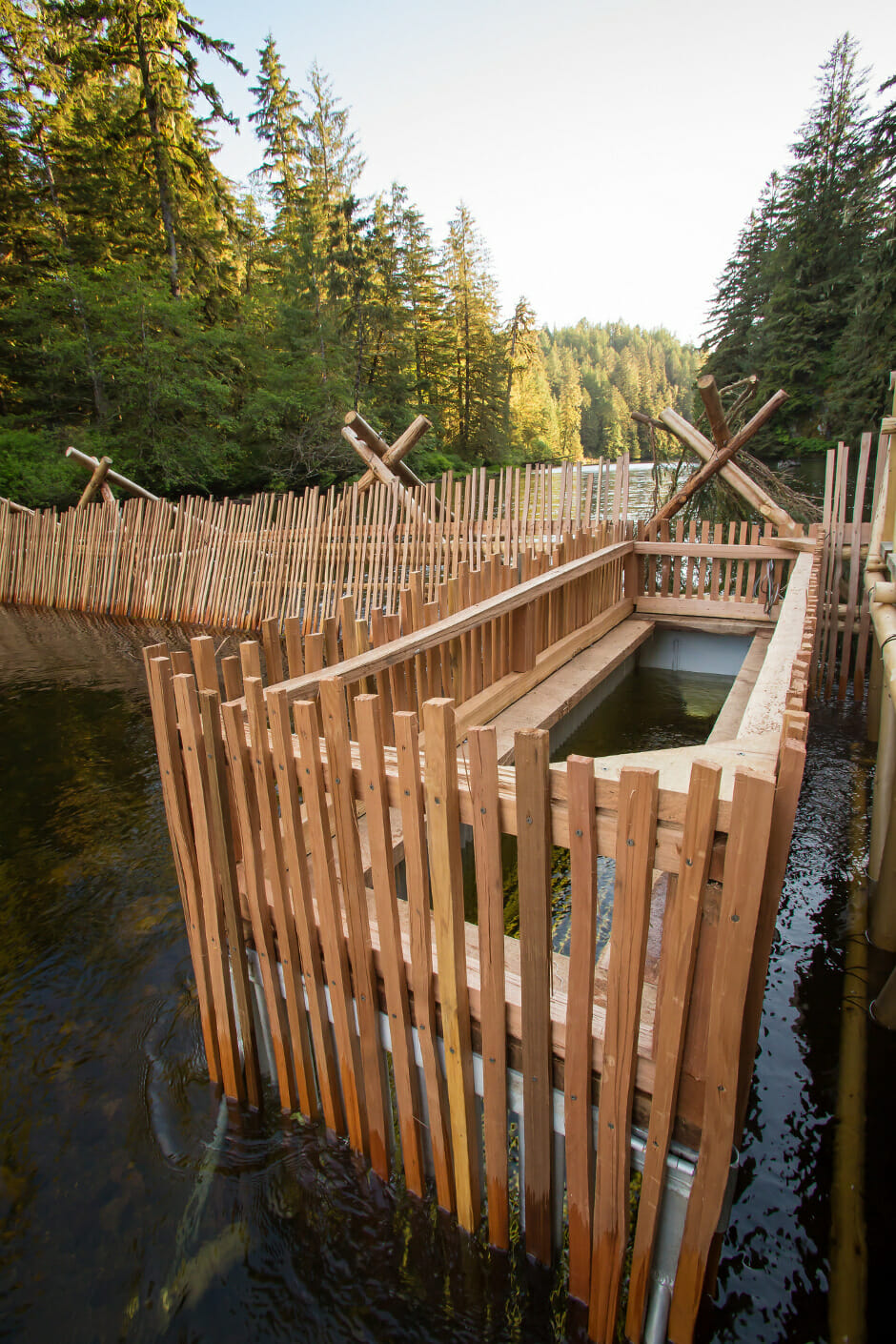Estimated Reading time

3 Mins
Heiltsuk Nation’s Koeye River Fish Weir Revives Traditional Fishing Practices

Working with the Heiltsuk Integrated Resource Management Department, scientists from Simon Fraser University’s Department of Biological Sciences, University of British Columbia’s Department of Statistics, and the Hakai Institute, the Qqs Projects Society built a traditional fish weir in the lower Koeye River—and then used it to generate a wealth of useful data about salmon health.
The weir – which is essentially a series of fence panels that span the river and that are supported by sturdy tripods – was designed (and erected in 2013) based on images and archeological evidence of traditional salmon weirs. Installed on June 1st of each year and operating until late July, the weir serves to guide fish, swimming upstream to spawn, into a trap box. At that point, the fish are briefly anesthetized, tagged for further monitoring, and released to continue their spawning journey. Each week of weir use is associated with a unique tag colour, which allows collection of detailed data about fish movements over the season. Researchers use sophisticated statistical techniques to analyze this data and understand critical relationships between rates of salmon survival and spawning, and factors such as daily river temperatures. This knowledge supports local resource management decisions and enriches our understanding of climate change.
https://vimeo.com/85332920
Weirs have used by First Nations in the Pacific Northwest for at least 5,000 years to selectively harvest returning salmon. Technologies such as fish weirs and stone fish traps (learn about the history of Kwiakah Nation’s fish traps in the Phillips River estuary) helped First Nations evaluate the strength of their salmon returns, and adjust their harvests accordingly, until the late nineteenth century, when they were banned by colonial governments seeking to prohibit First Nations fisheries and bolster commercial fishing. Today, weirs are commonly used by biologists for monitoring fishery health, but are rarely found in the First Nations fisheries where they evolved.
For project collaborators, the Koeye River weir—which has evolved from a pilot project into a key component of a 10-year salmon-monitoring plan—promises to reverse that trajectory. In addition to developing a mark-recapture method to produce estimates of population abundance to inform local fisheries management, it’s also building long-term capacity in the Heiltsuk community of Bella Bella. In the project’s first four years alone, 10 technicians were employed and trained; many have gone on to other resource management jobs. More than 200 students have visited the weir through school field trips, and the weir is frequently visited by campers at Qqs Projects Society’s summer camp. Through the project’s association with the Supporting Emerging Aboriginal Stewards (SEAS) program (the topic of another Coast Funds post here) one or two SEAS interns join the weir crew each year for intensive, hands-on mentorship that’s built into a multi-partner commitment to build stewardship capacity and channel kids into the sciences. All of this disseminates learning about time-honoured Heiltsuk practices around harvesting and stewardship of salmon.
The Qqs Project Society and its collaborators—which include William Housty, chair of the Heiltsuk Integrated Resource Management Department’s board of directors—are sharing their knowledge widely. They’ve just published a paper in the academic journal Ecosystem Health and Sustainability, describing the techniques, materials and best practices associated with weir construction and operation.
“We hope that the Koeye River weir can provide a template for other communities seeking to understand and manage salmon populations, and serve as a powerful example of the creative approaches to resource monitoring and stewardship which can arise from collaborations between First Nations communities and academic scientists,” conclude the researchers.
We hope that the Koeye River weir can … serve as a powerful example of the creative approaches to resource monitoring and stewardship which can arise from collaborations between First Nations communities and academic scientists
The project is part of a holistic human–bears–salmon approach to monitoring at Qqs’ environmental arm, Coastwatch. Many of the tools being piloted in the weir program support technician training in the Heiltsuk Integrated Resource Management Department, and are being adopted in other watersheds (although Koeye is the only one with an actual weir).
- Read more about the Qqs Project Society, the Heiltsuk First Nation nonprofit organization that supports youth, culture and the environment
- Read about the work led by the Heiltsuk Integrated Resource Management Department and efforts to protect Central Coast herring stocks
- Read more about the Heiltsuk fish weir at Koeye
Delve deeper into the researchers’ findings after four years of weir operation

Meet Heiltsuk Integrated Resource Management Department leaders, technicians and interns talk about the value of this program in Sitting on Water (the English translation of the Heiltsuk word Koeye): A Season on the Koeye River. This video made by the Qqs Project Society tells the story of the Heiltsuk First Nation and their work to ensure a sustainable future for their community’s salmon fisheries.
